Owen K.C. Stephens's Blog, page 37
October 13, 2021
ShadowFinder Class Preview: The Enigma
Today, I am going to continue actual OGL rule examples of some material coming in the Starfinder Infinite ShadowFinder book.
I wanted a class to fill the “modern character with weird powers” niche so common in much of the inspirational media that has influenced the form ShadowFinder took. This is more than being a spellcaster, or even something the psionic themetype I wrote up can represent. I needed a class for firestarters, dead zones, shining, heckspawn, and mutants.
I needed a way for a PC to be an enigma. So that because the class.
Here’s a preview of some elements of this new, 100% Starfinder-compatible, character class.
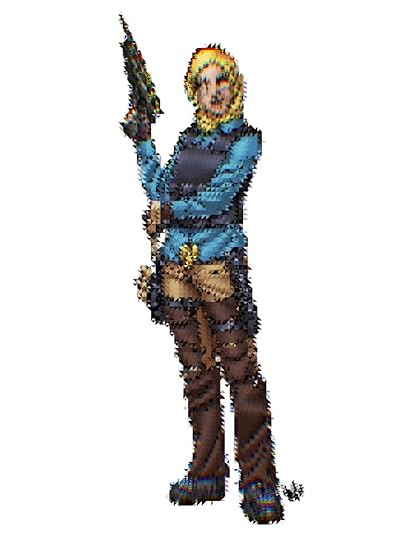 (Yes, I have new ShadowFinder art for all 8 classes I’m supporting in the ShadowFinder Core Book. No, this one is not the enigma. Yes, you’ve seen the enigma digitized tease already. Guess which one it is?!)
(Yes, I have new ShadowFinder art for all 8 classes I’m supporting in the ShadowFinder Core Book. No, this one is not the enigma. Yes, you’ve seen the enigma digitized tease already. Guess which one it is?!)Enigma
An enigma has power, but no one (not even the enigma) is sure why. Unlike spellcasters or combatants, it is not a trained or learned power, and unlike warlocks it is not part of some bargain for power from otherworldly forces. That doesn’t mean the enigma can’t train to use their powers more effectively, or that it might not have been bestowed by an entity beyond the enigma’s understanding, but no science or mystic research has yet to understand enigmas’ abilities, and the growing number of enigmas is seen by many groups as a rising threat.
An enigma has often had to hide for much of their life, at least early on. Their powers are hard to control when they first manifest, and can both disrupt the stability of a support group and attract attention from others. It’s not unusual for an enigma to be the product of some mysterious experiment who escaped, and to be hunted by their former keepers. Others seem to bloom with power on their own, but organizations exist who wish to find the source of that power, even if they have to cut it out of the enigma. As a result, many enigmas learn to be self-sufficient when young, both in urban and wilderness settings.
Once enigmas grow into their abilities, most groups consider opposing an enigma directly to be too dangerous, though organizations with more reach and resources may feel differently. An enigma does well to forge bonds with allies to ensure anyone interest in knowing how they manipulate energy, form, or even reality itself sees that the enigma is not alone, and has friends who will come after them if they disappear.
Hit Points: 6
Stamina Points: 6
Key Ability Score
Cha
While no one knows where the power that makes enigmas comes from, the fact that it fueled by their own force of personality seems clear. Enigmas may be bold or shy, honest or deceptive, friendly or hostile, but they all have the strong sense of self that makes them naturally apt at interpersonal relationships. Your Charisma determines the save DCs of your various enigma powers, and is thus your key ability score.
Class Skills
The enigma’s class skills are Bluff (Cha), Culture (Int), Diplomacy (Cha), Disguise (Cha), Intimidate (Cha), Medicine (Int), Mysticism (Wis), Profession (Cha, Int, or Wis), Sense Motive (Wis), Sleight of Hand(Dex), Stealth (Dex), and Survival (Wis)
Skill Points at each Level: 6 + Int modifier.
Proficiencies
Armor
Light armor
Weapons
Basic melee weapons, small arms.
(Yes, I am ending this preview before the class features table on purpose!)
Would You Like To Know More?
Want to ask questions about ShadowFinder? Would you enjoy access to a huge backlog of game stuff and articles? Simply want to support me creating more of these things? Check out my Patreon! This post has an Expanded Version on my Patreon as well, which talks a little about the design philosophy behind secret signs.
October 12, 2021
ShadowFinder Spells
Okay, let’s do an actual OGL rule example of some material coming in the Starfinder Infinite ShadowFinder book.
Since ShadowFinder is a new Play mode that focuses on a more modern aesthetic and theme, I want to add some things–like spells–that tie into that theme. These are simply ways for characters to feel more “Supernatural Kindred Stalker” than “Guardians of the Trek Wars.”
Here’s an example:
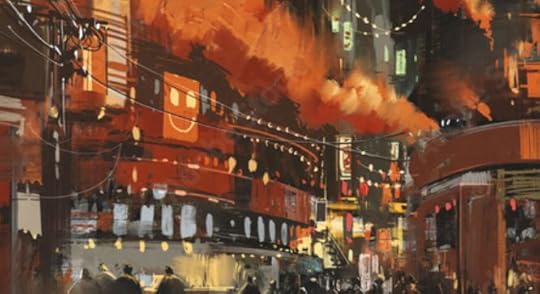 (Art by grandfailure)
(Art by grandfailure)Secret Signs [Technomancer 2]
School divination
Casting Time 1 round
Range personal
Duration instantaneous
Casting secret signs can tell you whether entering a specific commercial or public space that has signage (such as a store, restaurant, library, subway terminal, and so on) is likely to be helpful for accomplishing a specific goal you wish to accomplish there (such as buying a specific item, being able to travel to a given destination, finding a friend of yours, finding a police officers, and similar goals). You must have the specific goal in mind when you cast the spell, and it gives you information above every public or commercial location in your line of sight by changing how you see their signs, indicating good results with positive emojis (smiley faces, thumbs up, etc.), and difficult or unlikely locations with negative emojis.
The chance for successfully receiving a meaningful reply is 85%; this roll is made secretly by the GM. A result may be so straightforward that a successful result is automatic, or it may be so complicated as to have no chance of success. If the secret signs succeeds, you get one of four results.
*Thumb’s Up (if the location will probably aid in the goal).
*Thumb’s Down (if the location likely won’t aid in the goal).
*Shrug (If the location may aid, but such aid is dangerous, expensive, or hard to find once within the location)
*WTF (for locations that have neither especially good nor especially bad results).
If the secret signs isn’t successful, you get the “nothing” result. A spellcaster who gets the “nothing” result has no way to tell whether it was the consequence of a failed or successful casting.
The secret signs can only predict about 30 minutes into the future, so anything that might happen beyond that time frame does not affect the result. Thus, the result might not take into account the long-term consequences of a contemplated action. Multiple castings of secret signs by the same creature about the same goal in the same region use the same die result as the first casting.
Would You Like To Know More?
Want to ask questions about ShadowFinder? Would you enjoy access to a huge backlog of game stuff and articles? Simply want to support me creating more of these things? Check out my Patreon! This post has an Expanded Version on my Patreon as well, which talks a little about the design philosophy behind secret signs.
October 11, 2021
ShadowFinder Adventure Sketch
The ShadowFinder Core Book won’t include a full-length adventure–there’s neither time nor room to get one crammed into that first book–but it WILL include some GM/Adventure support. There will be a section that talks about how to take typical Starfinder Adventure Paths and “reskin” them for the ShadowFinder Play Mode. And there will be some Adventure Sketches.
These are short outlines of what an adventure might include, with sections outlining “What It Looks Like,” “What’s Actually Going On,” “How Do PCs Get Involved,” “How Does It End,” and “Then What.” They are designed for GMs to use as inspirations and jumping-off points, with just enough details to explain what the adventure is about and how it may go, but without so many it’ll be difficult to mold into an existing campaign’s events. For example, while this adventure sketch mentions “the city,” it doesn’t tell you if it happens in New York City, Tokyo, or Absalom. That’s up to the GM.
I kinda hate to preview an Adventure Sketch–they take a lot of effort to write compared to their size and I see them as being a big part of what makes the ShadowFinder book work, despite their relatively small wordcount–but for exactly the reason I want them in the Core Book, I think they do a great job of showcasing what kinds of stories I think ShadowFinder is going to be great for playing through.
So, I picked one of my favorites — Save the City Beneath — and am showcasing it here.
Save The City Beneath
What It Looks Like: Water is mysteriously disappearing. From the drinking water system, reservoirs, even entire rivers and lakes are showing water levels way, way below what they out to be. The systems are all connected to the city’s drinking system, and if the loss isn’t stopped, the entire city is going to have a water shortage.
What’s Actually Going On: The city sits atop “The City Beneath,” a subterranean mix of old, unmapped sewers, storm drains, bootlegger tunnels, heating shafts, closed-off basements, cisterns, bomb shelters, previous cities, and secret underground complexes, natural caves, mined-out salt mines, where a civilization exists with only sporadic contact with the normal city above them. The City Beneath has actual physical portals to the Shadowblast, but also to demiplanes with less malignant residents and much ancient lore and preserved mystic libraries.
The City Beneath is not an inherently evil place. It’s a city, with good people, bad people, homeless people, gangs, unions, charities, arks, and everything else you’d expect to find in a big city—just all underground. But a powerful and judgmental person or group in the upper class of the “normal” surface city (we’ll call them F.L.O.O.D. – Friends of Law, Order, and Organized Democracy) has decided the City Beneath is an unacceptable danger. This group wants to find the City beneath, scour it of everything of value and power, and destroy it.
So, FLOOD are flooding the lower sections of their own city—uncaring that they are drowning the homeless, flooding out the dispossessed, and terrifying the vulnerable members of the lower class in the process—to follow the water drainage into passageways to the City Beneath.
Of course, in the process they are also waking up and releasing things the City Beneath locked away as too dangerous centuries ago.
How Do PCs Get Involved: If the mystery of a regionwide water shortage centered on a major city isn’t enough to get the PCs poking around, when some monsters start popping up in basements, abandoned bank vaults, old tunnel systems, and trendy secret clubs, the PCs can be in the wrong place at the wrong time. Or, someone working for FLOOD might even try to hire the PCs to protect their water-trackers, hoping monster-hunters will blindly accept that the City Beneath must be “dealt with.”
How Does It End: The PCs figure out what FLOOD is up to, and either expose them to the public (which won’t result in anyone important going to jail, but will bring enough pressure for FLOOD to give up… for now), or hunt down and take out the FLOOD manager in charge of the deadly operation. FLOOD won’t be destroyed either way, but will decide such high-profile, headline-grabbing operations are a bad idea.
Then What: Assuming the FLOOD threat to the City Beneath is ended, the PCs now have access to an entire hidden society. In future adventures they can explore, train, use Coin of the Realm to buy magic items, set up bases, make allies, and go adventuring to deal with the City Beneath’s unsavory elements and gangs.
For inspiration on the City Beneath, look up the real-world locations of the Aldwych tube ghost statipn in London, England; Avinguda de la Llum in Barcelona, Spain; the Burlington Bunker in Corsham, England; the Cincinnati Subway in Ohio; Derinkuyu, Turkey; Dixia Cheng in China; the Estación de Chamberí abandoned subway station in Madrid, Spain; K’n-yan; Metro 417 in Los Angeles, California; Naours, France; New York City’s City Hall station; The Paris Catacombs, France; Poland’s Wieliczka Salt Mine; Portland Underground, in Portland, Oregon; Three Kings Catacombs in Tizimín, Mexico; and the Seattle Underground, in Seattle, Washington.
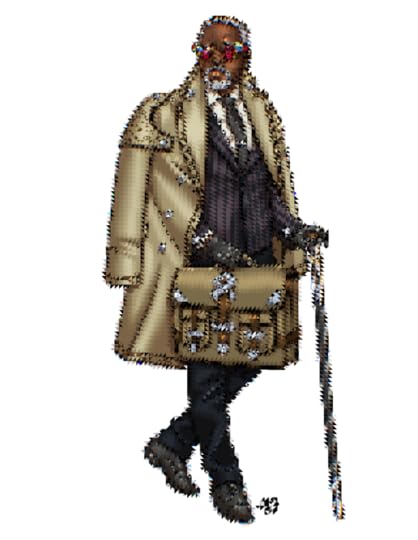 (Seriously, I can’t wait to show you all this Jacob Blackmon ShadowFinder art!)
(Seriously, I can’t wait to show you all this Jacob Blackmon ShadowFinder art!)Want to ask questions about ShadowFinder? Would you enjoy access to a huge backlog of game stuff and articles? Simply want to support me creating more of these things? Check out my Patreon!
September 29, 2021
Owen Explains It All – Musical Challenges for Starfinder
Before we get to any OGL content, an editorial aside:
First, this blog has spoilers for an animated series, so if you want to avoid those, don’t read this.
Second, you may be wondering why is this tagged as an “Owen Explains It All” post, when that’s very unlike my normal marketing tone? Well, because this links into a show from the BAMF podcast I’m on, titled “Owen Explains It All!“. We do an episode every two weeks, picking new things from the zeitgeek to use as inspiration for game material, specifically the Starfinder Roleplaying Game.
We have a logo and everything!

If you haven’t already gone and watched the September 27, 2021 episode, we talk about the Star Wars Visions animated shorts, and how one of them features a band that has to overcome challenge with their music, but NOT in a battle of the bands.
Which leads me to Musical Challenges, as OGL content
Musical ChallengesI already created a set of Battle of the Bands rules, designed to resolve a conflict between two or more musical groups, using a modification of the Starfinder chase rules. That’s great, as far as it goes, but what if you want a musical challenge that isn’t a direct competition among multiple groups? For example, what if a band of scifi musicians need to win over a crowd, and become so clearly popular a local gangster decides it’s more profitable to sponsor them than kill one of their members for a pervious misunderstanding?
Luckily, all you need to turn Battle of the Bands into any musical challenge is a way to create a set of statistics for a “Challenge Stat Block,” (CSB) that is decide that a given task requires the PCs to overcome a stat block with a Musical AC and Musical Item level, and an appropriate skill check. Once you do that, you can run each stage of the encounter as a 1-on-1 “battle of the bands” between the PC band and the challenge’s stat block.
Since those values are based on ranks, just decide the CSB has a number of ranks equal to the CR you want that stage of the challenge to be. So for 3rd level heroes, build the CSB off 3 ranks for a typcial challenge, or 5 ranks for a severe encounter. Then write up each stage of the Musical Challenge as a CSB, and run it like an opposing band.
If you need to have the Musical Challenge work with a specific existing NPC, use their CR for ranks if they have an appropriate master skill, or their CR -2 if they don’t. Similarly, for their own skill checks, use the total master skill bonus of an expert array creature of the same CR if they have appropriate master skills, and the god skills bonus of the array otherwise.
Here’s an example.
Our 3rd level scifi band of adventures, Heavy Sabre, is performing at a festival run by the gangster Massio, who plans to kill their drummer when they are done to enforce an old debt. The band needs to win the crowd over (Challenge Step 1), then convince Massio he’ll make more money promoting them than killing them (Challenge Step 2), which happens while his thugs are trying to get them off the stage.
Since Heavy Sabre is 3rd level, the Challenge Step 1 CSB is built using the 3 ranks as the assumed baseline. That gives “Winning Over the Crowd” a Musical Armor Class (MAC) of 13, and a Musical Item Level (MIL) of 13. When the “Winning Over the Crowd” CSB takes an action for relative positioning, it uses the master skill bonus of a 3rd level expert array (+10). Now run a battle of the bands between Heavy Sabre and the CSB, which gets one action a turn.
Once Heavy Sabre wins that, they must win over Massio. Massio is a 5th level gangster, so this will be much tougher. He has a MAC and MIL of 15. However, since he’s not an expert on music and is likely to be swayed by the crowd’s reaction, you can just use his good skill bonus of +11. Also, since there are thugs trying to get the band off the stage, the PCs will have to both fight a Battle of the Bands with this CSB, and fight off 2 thugs during the combat phase.
And that’s it! Any challenge that the GM decides can be overcome by musical expertise — winning over patrons, lulling savage monsters to sleep, putting ghosts of slain battle-drumming to rest–can now be handled by deciding how many steps it takes, and treating each as a Challenge Stat Block.
This is an Expanded Post, with some notes on how to adjust these rules to allow for ANY skill based challenge to be run available to my Patrons, who provide me with the support that makes these posts possible.
September 27, 2021
ShadowFinder is Coming!
So, first some legal stuff.
Nothing on this page is OGL. This is a post of Community Use content of Paizo materials.
And I am doing it because with the announcement of Pathfinder Infinite and Starfinder Infinite, I am, in fact, going to be doing ShadowFinders, like I have ben carefully not focusing on for a few years now.
So, what the heck is ShadowFinder? Well I’ll talk about it more once the first ShadowFinder product is up on Starfinder Infinite, but until then, let’s look at part of the introduction from that book.
What is ShadowFinder?
ShadowFinder is a Play Mode for the Starfinder Roleplaying Game. What do we mean by “Play Mode?” We mean this is not a new game, or even a new campaign. It’s just a way to play Starfinder and get a different feel, and be focused on different kinds of stories. You don’t need to learn a new system, and while we tweaked a few things to better support the playstyle we expect game groups to use for ShadowFinder, none of that is mandatory.
Specifically, ShadowFinder is a game about being on a world with a technology level very like the Earth currently has, and yet a world with a great deal of magic as well. In fact, one of the two places we assume you’ll play ShadowFinder is Earth… but an Earth that has been very different since heroes from Golarion arrived during WWI to kill Rasputin. The other world is Golarion, but not only is it much further along in its technological development, it’s been cut off from all the rest of the universe by some sort of cosmic Gap, and Torag is the only god that directly talks to people anymore.
In both these worlds there is what is known on the surface… and then greater threats that lurk in the Shadows. Specifically, there is the Shadowblast (“Shadобласть,” in the first Soviet notes to talk about it), a hazy and semi-substantial place that seems to be a overlapping blend of the Shadow Plane, First World, and some infernal planes. Journying from Golarion to Earth apparently left a scar in the Astral plane, and the Shadowblast is a demiplane that has formed within that scar.
On Earth, the Shadowblast has been the source of magicand magic creatures to seep into the world, bringing back energies and secrets kept locked away since the Old Egyptian Gods left the world. On Golarion, the Shadowblast is a way for the planar flotsam and jetsam to wash ashore in this Gap-severed pocket of the Material Plane, causing things from Earth to arrive… but also horrors and travelers from other realms who are pretty annoyed that, once on Golarion, they seem stuck here forever.
And in both worlds, the Shadowblast is clearly a thing being explored by alien empire far from known space, as shirren, ysoki, vesk, and other species find themselves dumped out of the planar darkness, generally suffering great confusion and memory loss. And, it seems, less savory things from the Void have been visiting, and perhaps even leaving, with grays and reptoids the least horrific of these threats.
Whether playing in a relatively normal-looking Deep Shadows game on Earth, where the general public is still in the dark about the growing eldritch threats, or a Shadows Everywhere game on either world, where magic and mythic species are well-known, but the true danger from the Shadowblast remains a problem only a small fraction of people are willing to do anything about, the PCs take on the role of ShadowFinders, trying to mitigate the damage from things leaking out of (and sometimes plotting from within) the Shadowblast, while seeking answers to the true nature of the incursions that are growing in frequency and intensity.
Welcome to ShadowFinder.
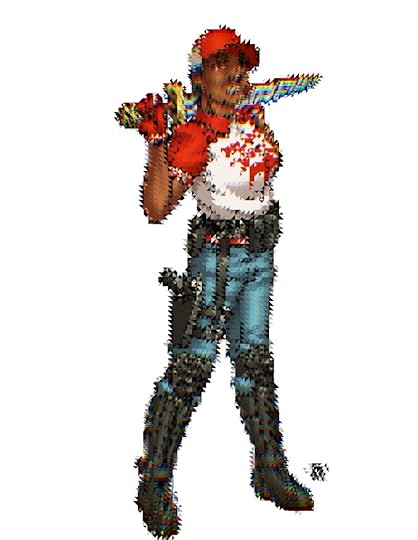 (I literally cannot show you this amazing ShadowFinder image by Jacob Blackmon yet. But, soon!)
(I literally cannot show you this amazing ShadowFinder image by Jacob Blackmon yet. But, soon!)Want to ask questions about ShadowFinder? See a huge backlog of game stuff in articles? Just like my stuff and want to support its creation? Check out my Patreon!
September 24, 2021
The Icosantheon. No 20 — Aor
The Icosantheon is a host of twenty deities bound not by a common origin, but by a united conservatorship of the immaterium that forms the sides and edges of the material plane.
 (Art by grandfailure)
(Art by grandfailure)Aor is among the most unusual of deities in the Icosantheon, as it is not perceived as self-aware. Rather Aor is the Beacon Tower, the very first structure created by mortals to serve as a warning to others. It is believed to be the first structure made by any civilization to be so tall it’s top could not be reached by one standing on the shoulders of another, the first made of stone, the first to have artifice and magic both involved in its creation, and the first built by more people than the land around it could support, requiring the coordination of multiple communities over months or years.
Thus Aor became a thing early civilizations would swear by, and call upon when attempting to rally people. Aor represents the act of creation and cooperation not to destroy, or even to defend, but to warn. A nonviolent transmission of data that required people struggling and sacrificing in order to pass a benefit on to later generations. While there is significant disagreement about when, where, and by who the true Aor was built, that made no difference to it’s growth as a symbol. And much as the sun, or the ocean, or the wind could act as a divine force with no anthropomorphization, so, too, could the Beacon Tower.
The first worshippers of Aor were essentially philosophers and planners who discovered that parables about the effort needed to build Aor, and the benefits that were reaped not by those who did so but those who came after, granted them more than just wisdom. Stories spread, and were compiled, talking about the need to maintain Aor so it would not fall into disrepair, to man it so the beacon could be lit as needed, to set aside some effort of a community to keep the advantages Aor had granted them. Aor became a symbol of a thing mortals did without the gods, and in doing so took the palce of gods in the minds of many.
Aor has no tenets, being an inanimate object, but its worshippers actively promote the ideas that must have held sway when it was constructed. They see themselves as beacons of their own, looking for dangers to entire societies and teaching the needed behaviors that will prepare populations to be ready for such threats.
*Aor is Neutral, and accepts worships of all non-chaotic alignments. The essential quality to worship Aor is to accept that there are benefits of forethought, and working together, and maintaining that which has been wrought. Such beleifs can be applied to good and evil, to strict laws or general trends, but do not mesh well with those who hold individual freedom of choice above joint, organized action.
*Aor’s color is gray — the gray of rock, stone, and dust gathering in ancient corners. Often Aor is represented by a single vertical gray stripe, which may be placed in the center or to the left of any other pattern or image.
*Aor’s favorite weapons are hammers, which were used to help craft and place it.
*Aor’s favored animal is the ganet. There are debates about why. Ganets are seabirds, suggesting the Beacon Tower might have been the first ligthhouse. Ganets are also famously fearless and easy ot kill, perhaps suggesting they need Aor more than other animals.
*Its servitors are non-chaotic outsiders linked to architecture and crafting, regardless of their other affiliations.
*Its holy symbol is a tower with a light or bolt at the top, spiraling outward from it.
*Its areas of concern are architecture, cooperation, communication, diligence, forethought, navigation, teaching, and warning.
*Its domains are Artifice (industry, toil), Community(cooperation, education), Rune (wards), Sun (light), Travel (trade), and Water (oceans).
Worshipers of Aor are often gifted with divine foresight, and an inherent understanding of construction. They may give up any skill known to gain Knowledge (Engineering) and have one bonus rank in that skill per level (still limited to max ranks equal to their level). Additionally, any worshiper of Aor that receives a domain, hex, or mystery can sacrifice a domain power, hex or, revelation to gain a power from the divination wizard school, or any of its subschools, that could be gained at the same or lower level.
PatreonIf you got any use out of this article, or have enjoyed any of my content, or are just looking for a way to support my work, please consider supporting my Patreon to cover the cost of my doing it. You can join for the cost of a cup of coffee a month.
September 23, 2021
The Icosantheon. No 5 — Eirsival
The Icosantheon is a host of twenty deities bound not by a common origin, but by a united conservatorship of the immaterium that forms the sides and edges of the material plane.
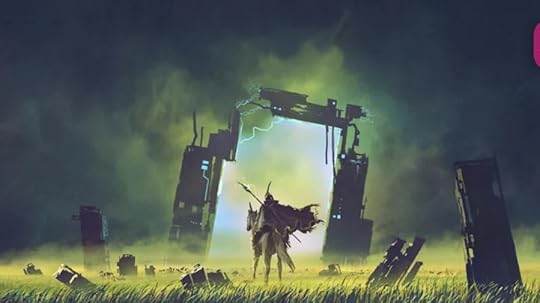 (Art by grandfailure)5. Eirsival
(Art by grandfailure)5. EirsivalEirsival is known as the Knight of the Final Thunder and the Coming Storm. She is the last of the Storm Mothers, agents of the primal divinities from before the fall of the Cthonic Gods. The Storm Mothers oversaw the destiny of those who would die defending others. In a twist of what could be considered irony, they were unable to foresee their own destiny, dying to defend the birth of mortals during the Gogolmachy when gods and elder beings first came into direct conflict and destroyed so much of reality, including entire alternate histories and places where technology was far more advanced than the current world.
Along with the other Storm Mothers and the First Heroes they had guided, Eirsival stood to hold the Final Line against aberrant horrors that sought to unmake the rules of the material plane. Had they failed, there would be no natural order to things, just a whirling tumult where the will and power of an entity were the only limits of what it could force others, and matter itself, to become. Though the Final Line did not break, when the maelstrom fell back, only Eirsival and Ixalicor, the progenitor of all unicorns, remained. Ixalicor swore to serve as Eirsival’s mount for all time, and Eirsival swore that those who defended the innocent, weak, and abused should never have to do so alone.
And in that moment, she went from the last of a line of angelic servants to being a deity.
Eirsival neither requires nor even requests worship, as she wishes to support all righteous defenders, whether they pay her obeisance or not. However, that very fact draws some to venerate her and wish to spread her name, and as long as they do so in the name of protecting a better world and respect the lives in the current world, she does not refuse them. Her temples are few, but tend toward massive fortifications that can take in and defend vast populations when needed. Slightly more common are stables and cavalry forts with a small shrine to her, as the friendship between her and Ixalicor has carried down to many forms of equine.
Eirsival believes that rules and order are a necessary part of protecting the rights and dignity of all things, but she also accepts that rules and order can be used for darker purposes. Thus while she has a natural distrust of anarchy and randomness, she does not inherently oppose it until it begins to impinge on her quest to protect all. Eirsival is a close ally with Karrackar, and where she and the Shade Dragon disagree on some finer details of how to best proceed, their mutual respect is so great they simply defer to one another within their specific areas of concern. Eirsival actively dislikes Garuuhl, and considers him excellent proof that if the ends is sued to justify the means, evil will eventually result. She largely ignores other members of the Icosantheon, and other gods in general, unless their interests and goals somehow overlap or oppose her own.
*Eirsival is Lawful Good, and accepts worships of all good alignments, and those who are Lawful Neutral. She supports all efforts to protect and aid others, and acknowledges that there are often many ways to do so, but does not tolerate evil in any form, or anarchy for the sake of anarchy.
*Eirsival’s colors are sky blue, silver, and pearly white, often in wind and cloud motifs. However, her colors are for times when color is appropriate, her worshippers feel no pressure to embrace those colors unless they both desire to and are safely can.
*Her favorite weapons are any form of lance or spear, most often one sheathed in lightning.
*Her favored animal is the horse and all horselike creatures, especially pegasi, unicorns, and hippogriffs.
*Her servitors are winged unicorns the color of thunder and lightning, tengu spearmasters who are wandering teachers, and smiths, especially lance-smiths.
*Her holy symbol is a single bolt of lignting, surrounded by darkness.
*Her areas of concern are .
*Her domains are Air (cloud, lightning, wind), Glory (chivalry, heroism, and honor), Good (friendship), Law (loyalty), Protection (defense, fortification, and solitude), and Weather (storms).
Any worshipper of Eirsival who is of good alignment and has the animal companion class feature can take the Unicorn Companion feat, even if they do not otherwise meet its prerequisites. Additionally, her worshipers can gain the feat and the animal companion feature needed to use it by giving up specifi class features based on their class: cleric (one domain), inquisitor (domain and stern gaze), oracle (revelations from 1st, 7th, and 15th level), shaman (spirit animal), warpriest (both blessings).
PatreonIf you got any use out of this article, or have enjoyed any of my content, or are just looking for a way to support my work, please consider supporting my Patreon to cover the cost of my doing it. You can join for the cost of a cup of coffee a month.
September 22, 2021
Guarded Trick Exploit for Starfinder
Okay, today it’s just an idea I have been mulling for a while.
Operative Exploits2nd LevelYou must be at least 2nd level to choose these exploits.
Guarded Trick (Ex): When you make a trick attack, in place of any other movement you could normally take, you may take a guarded step.
PATREON
If you are enjoyed this, please consider adding a drop of support through my Patreon campaign!
September 21, 2021
Making Combat Interesting: The Really Wild West Clockwork Platform Fight
I recently ran a fight in my Really Wild West campaign, using Starfinder rules, that took place atop a series of spinning, moving, shifting gears. Overall, it was big hit.
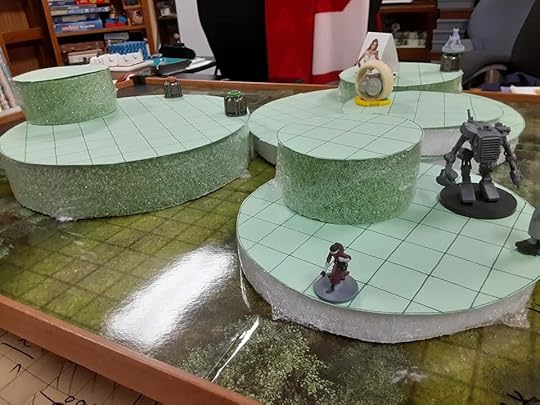 (Plus a hodge-podge of objective markers, miniatures, models, and standees)
(Plus a hodge-podge of objective markers, miniatures, models, and standees)
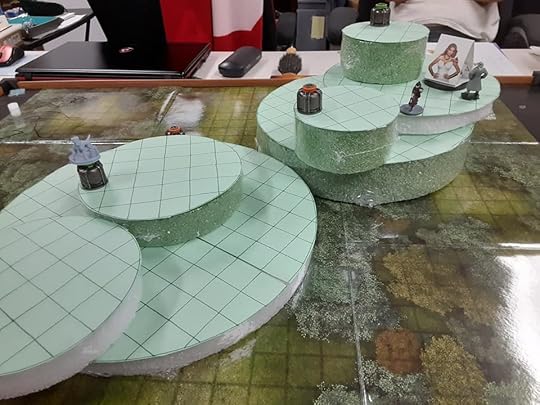 (and one 3D printed mechanical dog, used to represent the old west mechanic’s steampunk canine drone)
(and one 3D printed mechanical dog, used to represent the old west mechanic’s steampunk canine drone)Now, this was made much easier by the fact that one friend of mine made these big green gridded disks from flower/cake foam (to use as hills and such), and other got this spinning, sliding lazy susan tabletop. So all I had to do was tell folks the disks were big bronze gears, spin and turn them (they both rotated on their own axis, and spun around each other at different speeds), and players could rotate the whole map if they needed to see what was on the far side of the gear-pile.
I warned people that the mechanism was so complex as to be essentially unpredictable, so while I tried to follow some basic rules on how things spun and moved, if I messed up players knew that randomness was intended. While the gears were officially in constant movement I just relocated them at the end of each round, so players always had a chance to react to one position before they formed a new one (and, after all, realistically the characters are in “constant motion” as well).
On top of the big moving gear platforms, there were two sets of “control cogs,” parts of a Babbage system that controlled the movement of the gears (orange markers), and the actions of the constructs defending them (green markers). The mechanic in the group managed to get access to those things, though it wasn’t easily, and one-by-one shut down the constructs while their allies used mobility (including good Acrobatics or Athletics checks and actual mobility to avoid attacks from spinning gears as the dodged about), flight, and climbing to move around.
So, this encounter had fairly normal combatants, but a lot of other things going on as well. In fact I kept the combatants pretty straightforward (well… one had a steam-pressure triphammer than could boost for multiple rounds to gain more and more bonus dice to its next attack) just so I wasn’t throwing too much at the players.
I’ve done similar things with moving elements before–fighting on rafts in rivers choked with floating logs, conflicts on trains both mobile and stationary, running battled through tunnels with teleportation gates, stampedes as hazards with big rocks to hide behind and every other space counting as an attack of opportunity as you try to avoid being trampled–but I think this is the most complex and multi-moving-part encounter I’ve done. And my players are all veterans of gaming and general and, at 9th level, this campaign and these characters in particular.
And it’s fairly easy to spice things up with doing so far as to have two Jedi battle it out on rocks bobbing along streams of lava with guard skiffs flying by. A battle behind a waterfall makes everything wet, and drowns out all noise. Defending a wall gives all the PCs cover–or all the PC’s foes cover, depending on which side of the wall they are on. A cliffside fight is all about climbing up, down, and sideways rather than running N, S, E, and W. Fights on frozen ponds, or in hurricanes, or in grass fields that stand 12 feet tall — not only do these things give the players a new experience, it can make various class and ability options they take worthwhile. Who wants to move freely through natural terrain if there isn’t the occasional thorny bramble covering 13 of the map, with grig archers shooting out of it?
You don’t need to shake things up in every battle, but just a few props now and then, or a different kind of terrain or local hazard, can help a specific encounter be memorable.
PATREON
If you are enjoyed this, please consider adding a drop of support through my Patreon campaign!
September 20, 2021
The Traumatic Weapon Property for Starfinder/ShadowFinder
Sometimes, you have to decide if an idea is worth the mental load adding it causes the game to gain.
Stamina Points and Hit Points are wildly unrealistic simulations of how creatures and objects take damage. After all, people who are stabbed once sometimes die, people who are stabbed 30+ times sometimes survive. Similar numbers are true for gunshot wounds, and often the people involved are sufficiently typical there’s no reason to suspect they are secretly 11th level heroes with a vast pool of damage points… or that the people who kill with a single attack are pulling off massively high-level trick attacks.
But SP and HP aren’t efforts to model reality. They are gameist rules designed to make it easy to know if a character is being hurt, near death, or dead. Often the situations they create are pretty clearly at odds with typical reality, even if possibly within the realm of things that have happened a few times in medical history. But the rules do a good job of indicated levels or harm, allowing resource management to help track available healing and rest times, and allowing players a metric by which they can gauge the threat posed by a wide range of threats.
Normally, you look at changing rules to make them easier, faster, more realistic, or more “fun,” (which can, admittedly, encapsulate a lot of potential elements). While it would be pointless to try to make weapon damage more “realistic” in a system using SP/HP, due to the inherent gameist nature of that system, there is, however, another potential reason to have firearms work differently than melee weapons in Starfinder (or a compatible modern version, perhaps ShadowFinder) – genre emulation. While lots of supernatural monster hunters in genre fiction have shotguns and pistols, others with access to such materials restrict themselves to knives, axes, and wooden stakes, and go so far as to claim firearms never help.
And there IS a difference between the way a bullet damages a soft target and the way it damages a hard one. The vast speeds of bullets means they often deform and warp soft tissues in a much larger area than the wound track, whereas a stiletto punching the same size whole in someone lacks that additional damage mechanic.
So, maybe we want bullets (and maybe some other weapons) to work differently than other damage-dealers… sometimes. Kinda.
So, what if we create a new weapon property, called “traumatic”?
Traumatic: A traumatic weapon is one that does a significant amount of soft-tissue and propagating damage, such as a gunshot’s effects through hydrostatic shock. When used to damage a target that has no hardness and no DR, traumatic weapons deal additional damage equal to the listed amount (such as “traumatic +1d6”).

Kinda like Boost and some other traits, traumatic gives you more damage, but only in specific circumstances. I’d have to do a lot of math and comparisons to know exactly how much extra damage traumatic can add at any given level… and I’m not sure it’s worth it
Sometimes you have to craft a rule before you know if you like it. I’m really on the fence with this one. So I can try to adjust it until I like it, ir discard it and start over… or just decide it’s a bad idea.
But even fi I do that, I’m saving it in my archived files. Sometimes a bad idea for one game or function turns out to be just what you need for another project.
PatreonIf you got any use out of this article, or have enjoyed any of my content, or are just looking for a way to support my work, please consider supporting my Patreon to cover the cost of my doing it. You can join for the cost of a cup of coffee a month.
Owen K.C. Stephens's Blog
- Owen K.C. Stephens's profile
- 7 followers



